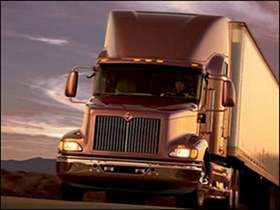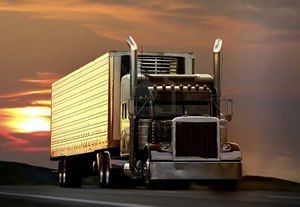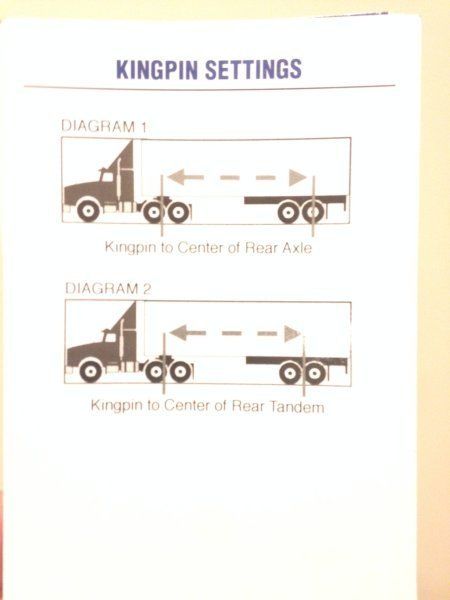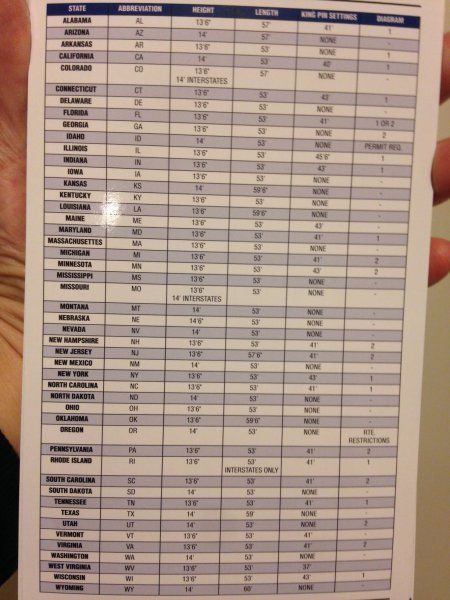Load/tandem Movement Question
Topic 16340 | Page 1
Stupid question real quick. Lol Does it matter rather truck is loaded half or full on where to put the tandems if both loads weigh exactly the same?
So one load is filled half or 3/4 the trailer and weighs 40500. The other load is loaded clear back to doors and weighs the same 40500.
Would you put tandems in same hole on both loads or move it back a couple on trailer that filled to the doors?
Put it back a couple on the one clear to the doors. Just know your tandem laws so you don't put them too far back.
Tandems:
Tandem Axles
A set of axles spaced close together, legally defined as more than 40 and less than 96 inches apart by the USDOT. Drivers tend to refer to the tandem axles on their trailer as just "tandems". You might hear a driver say, "I'm 400 pounds overweight on my tandems", referring to his trailer tandems, not his tractor tandems. Tractor tandems are generally just referred to as "drives" which is short for "drive axles".
Tandem:
Tandem Axles
A set of axles spaced close together, legally defined as more than 40 and less than 96 inches apart by the USDOT. Drivers tend to refer to the tandem axles on their trailer as just "tandems". You might hear a driver say, "I'm 400 pounds overweight on my tandems", referring to his trailer tandems, not his tractor tandems. Tractor tandems are generally just referred to as "drives" which is short for "drive axles".
It will make a difference. The more evenly distributed the load is, the more evenly distributed the weight will be. If all the weight is up front, it will put more weight on your drives. If all the weight is in back, more weight on your tandems. After you scale, always slide your tandems towards the problem.
Tandems:
Tandem Axles
A set of axles spaced close together, legally defined as more than 40 and less than 96 inches apart by the USDOT. Drivers tend to refer to the tandem axles on their trailer as just "tandems". You might hear a driver say, "I'm 400 pounds overweight on my tandems", referring to his trailer tandems, not his tractor tandems. Tractor tandems are generally just referred to as "drives" which is short for "drive axles".
Tandem:
Tandem Axles
A set of axles spaced close together, legally defined as more than 40 and less than 96 inches apart by the USDOT. Drivers tend to refer to the tandem axles on their trailer as just "tandems". You might hear a driver say, "I'm 400 pounds overweight on my tandems", referring to his trailer tandems, not his tractor tandems. Tractor tandems are generally just referred to as "drives" which is short for "drive axles".

More weight towards the front of the trailer means more weight on the drives. You would very likely need to move the tandems forward to compensate. Think of your trailer tandems as the balance point on a teeter-totter. The heavier kid needs to be closer to the balance point to keep things even. You want to have the weight as close to even on the drives and tandems as possible while keeping your knigpin distance legal. There are plenty of resources online (or your company can probably provide them) that show the legal lengths for each state. There may be occasions (winter for instance) where you want more weight on the drives for traction. I know firsthand that the DOT will usually ignore the steer axles being a bit overweight, but the drives and tandems need to be at 34,000 or under.
Tandems:
Tandem Axles
A set of axles spaced close together, legally defined as more than 40 and less than 96 inches apart by the USDOT. Drivers tend to refer to the tandem axles on their trailer as just "tandems". You might hear a driver say, "I'm 400 pounds overweight on my tandems", referring to his trailer tandems, not his tractor tandems. Tractor tandems are generally just referred to as "drives" which is short for "drive axles".
Tandem:
Tandem Axles
A set of axles spaced close together, legally defined as more than 40 and less than 96 inches apart by the USDOT. Drivers tend to refer to the tandem axles on their trailer as just "tandems". You might hear a driver say, "I'm 400 pounds overweight on my tandems", referring to his trailer tandems, not his tractor tandems. Tractor tandems are generally just referred to as "drives" which is short for "drive axles".
DOT:
Department Of Transportation
A department of the federal executive branch responsible for the national highways and for railroad and airline safety. It also manages Amtrak, the national railroad system, and the Coast Guard.
State and Federal DOT Officers are responsible for commercial vehicle enforcement. "The truck police" you could call them.

Stupid question real quick. Lol Does it matter rather truck is loaded half or full on where to put the tandems if both loads weigh exactly the same?
So one load is filled half or 3/4 the trailer and weighs 40500. The other load is loaded clear back to doors and weighs the same 40500.
Would you put tandems in same hole on both loads or move it back a couple on trailer that filled to the doors?
I don't see a stupid question here.
As others have said, yes, it does matter.
If you have a 40,500 lb load, all the way back to the doors, and it's evenly distributed, you will probably have to push your tandems back towards the doors, at least three or four holes.
If the same weight load is all in the front 3/4 of the trailer, then you will definitely want your tandems far forward, away from the doors.
Examples:
On the load before this load I have now, I had a 43,000 load with 21 standard pallets. One in the nose, then paired longwise to stretch out the load. The last two pallets were sitting over my tandems. I had the trailer in first hole, and with a full tank of fuel I was roughly 33,500 on tandems and 33,000 on drives, 11500 on steers.
A couple months ago, in a different truck, I had a 44,000 load that filled the trailer, and a gross weight of right at 80,000 lbs with less than half a tank of fuel. In order to keep the tandems below 34,000, I had to go back to the eighth hole, which would be an illegal load in some states.
Tandems:
Tandem Axles
A set of axles spaced close together, legally defined as more than 40 and less than 96 inches apart by the USDOT. Drivers tend to refer to the tandem axles on their trailer as just "tandems". You might hear a driver say, "I'm 400 pounds overweight on my tandems", referring to his trailer tandems, not his tractor tandems. Tractor tandems are generally just referred to as "drives" which is short for "drive axles".
Tandem:
Tandem Axles
A set of axles spaced close together, legally defined as more than 40 and less than 96 inches apart by the USDOT. Drivers tend to refer to the tandem axles on their trailer as just "tandems". You might hear a driver say, "I'm 400 pounds overweight on my tandems", referring to his trailer tandems, not his tractor tandems. Tractor tandems are generally just referred to as "drives" which is short for "drive axles".
Stupid question would be "Does anyone here know my truck number?" Lol

Freebird wrote:
Stupid question real quick. Lol Does it matter rather truck is loaded half or full on where to put the tandems if both loads weigh exactly the same?
So one load is filled half or 3/4 the trailer and weighs 40500. The other load is loaded clear back to doors and weighs the same 40500.
Would you put tandems in same hole on both loads or move it back a couple on trailer that filled to the doors?
My rule of thumb for any load in excess of 30,000 pounds is to scale it. Let the recorded weights determine the best placement of your tandems; first to be legal, second to be balanced as much as possible. And like Old Roadie mentioned, you need to understand the legal kingpin setting laws for each state you are routed through. Some states do not have any setting restrictions, others will enforce it. See the below photos for State's Guidance on Kingpin settings:


Tandems:
Tandem Axles
A set of axles spaced close together, legally defined as more than 40 and less than 96 inches apart by the USDOT. Drivers tend to refer to the tandem axles on their trailer as just "tandems". You might hear a driver say, "I'm 400 pounds overweight on my tandems", referring to his trailer tandems, not his tractor tandems. Tractor tandems are generally just referred to as "drives" which is short for "drive axles".
Tandem:
Tandem Axles
A set of axles spaced close together, legally defined as more than 40 and less than 96 inches apart by the USDOT. Drivers tend to refer to the tandem axles on their trailer as just "tandems". You might hear a driver say, "I'm 400 pounds overweight on my tandems", referring to his trailer tandems, not his tractor tandems. Tractor tandems are generally just referred to as "drives" which is short for "drive axles".
New Reply:
New! Check out our help videos for a better understanding of our forum features

















Preview:








 TT On Facebook
TT On Facebook
Stupid question real quick. Lol Does it matter rather truck is loaded half or full on where to put the tandems if both loads weigh exactly the same?
So one load is filled half or 3/4 the trailer and weighs 40500. The other load is loaded clear back to doors and weighs the same 40500.
Would you put tandems in same hole on both loads or move it back a couple on trailer that filled to the doors?
Tandems:
Tandem Axles
A set of axles spaced close together, legally defined as more than 40 and less than 96 inches apart by the USDOT. Drivers tend to refer to the tandem axles on their trailer as just "tandems". You might hear a driver say, "I'm 400 pounds overweight on my tandems", referring to his trailer tandems, not his tractor tandems. Tractor tandems are generally just referred to as "drives" which is short for "drive axles".
Tandem:
Tandem Axles
A set of axles spaced close together, legally defined as more than 40 and less than 96 inches apart by the USDOT. Drivers tend to refer to the tandem axles on their trailer as just "tandems". You might hear a driver say, "I'm 400 pounds overweight on my tandems", referring to his trailer tandems, not his tractor tandems. Tractor tandems are generally just referred to as "drives" which is short for "drive axles".